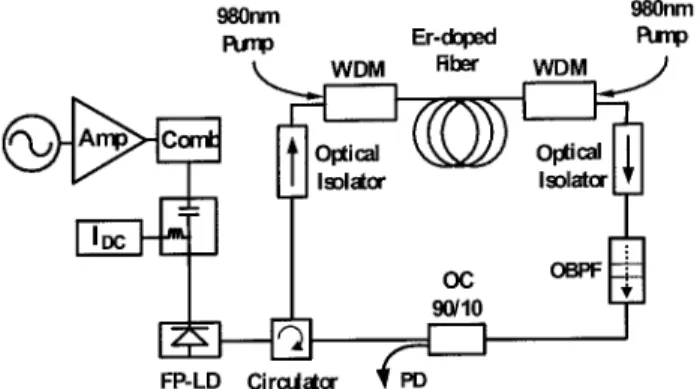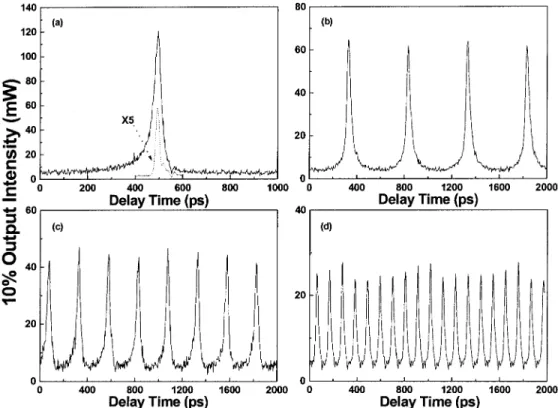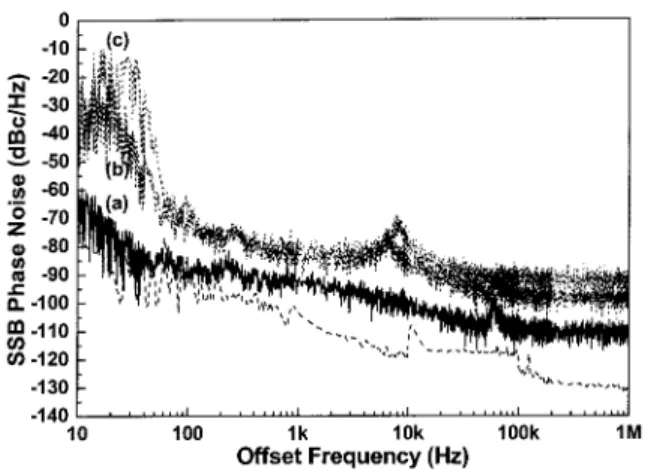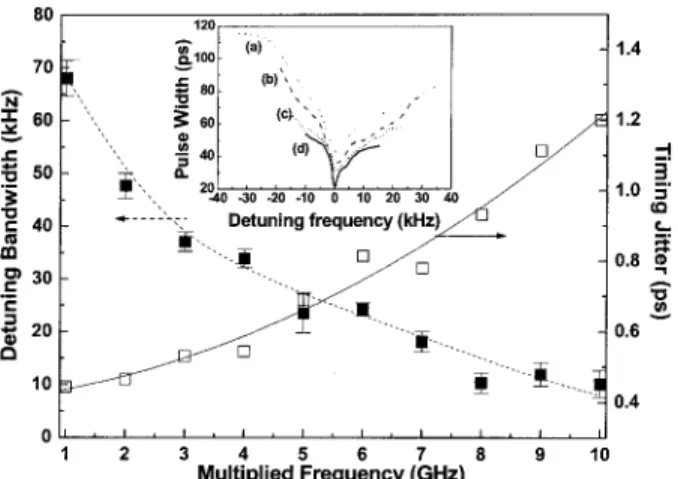Tenth-order rational-harmonic frequency
multiplication and detuning of optical pulse
injection-locked erbium-doped fiber laser
Gong-Ru Lin and Jung-Rung Wu
The jitter and frequency-detuning dynamics of a 10᎑GHz rational-harmonic frequency-multiplied pulse train generated from an erbium-doped fiber laser (EDFL) is studied. The EDFL is self-feedback seeded and optically injection locked by a gain-switched laser diode (GSLD) with a pulse width and an average power of 17.6 ps and 0.2 mW, respectively, at a repetition frequency of 1 GHz. The repetition frequency of the optical pulse train can be tenth-order multiplied by a slight detuning of the repetition frequency of the GSLD to match the rational-harmonic injection-locked condition of the EDFL. As the repetition frequency is multiplied from 1 to 10 GHz, the peak power, the pulse width, and the frequency-detuning bandwidth of the injection-locked EDFL pulses decrease from 1.2 to 0.3 W, from 40 to 21 ps, and from 40 to 9 kHz, respectively. The timing jitter of the injection-locked EDFL repeated at 1 GHz remains un-changed共⬍0.5 ps兲 within the detuning bandwidth, which inevitably increases to 1.2 ps after tenth-order multiplication. © 2005 Optical Society of America
OCIS codes: 140.3520, 060.2320.
1. Introduction
High-repetition-rate optical pulse generation and multiplication techniques have been investigated ex-tensively for applications such as optical time-division multiplexing and soliton transmission systems. Some novel approaches to pulse generation, such as fiber dispersion,1 intracavity fiber Fabry–
Perot filtering,2 optical-pulse injection,3,4 and
all-optical modulation5 mode-locking schemes, have
been investigated. Mak et al.5 previously
demon-strated tunable optical pulse-train generation of a gain-switched Fabry–Perot laser diode (GSLD), using fiber-dispersion-based repetition-rate multiplica-tion.6,7The phase noise and jitter dynamics of
mode-locked and regeneratively mode-mode-locked erbium-doped fiber lasers (EDFLs) have been studied in more detail by Gupta et al.8 However, rational-harmonic
fre-quency multiplication and detuning dynamics, and the phase noise as well as the jitter performance of
EDFLs that are injection locked by GSLDs, have been less discussed. In this paper we study the injection-locking bandwidth and the jitter response of a 10᎑GHz repetitive pulse train generated from EDFL injection locking by a GSLD at 1 GHz. Such a tenth-order rational-harmonic frequency-multiplied optical pulse train from the EDFL is shown to exhibit rela-tively low supermode noise and jitter and high aver-age output power with fairly good stability at repetition frequencies of as much as 10 GHz. The behavior of the 10᎑GHz rational-harmonic frequency-multiplied EDFL pulses in terms of pulse width, peak, and average power; single-sideband phase noise; and relative timing jitter are discussed relative to the detuning of the pulses’ repetition frequency from the closest harmonic resonant frequency of the EDFL cavity.
2. Experimental Setup
The optically pulse-injection-locked and rational-harmonic frequency-multiplied EDFL system is shown in Fig. 1. The active medium in the EDFL is a homemade erbium-doped fiber amplifier (EDFA) with a 6᎑m-long Er-doped fiber (Lucent, R37005), which is bidirectionally pumped by two 980᎑nm laser diodes with 140᎑mW power. The EDFA is self-feedback seeded (closed-loop) to achieve EDFL oper-ation and is simultaneously injection locked by a commercial fiber-pigtailed Fabry–Perot laser diode
G.-R. Lin (grlin@faculty.nctu.edu.tw) and J.-R. Wu are with the Department of Photonics and Institute of Electro-Optical Engi-neering, National Chiao Tung University, 1001, Ta Hsueh Rd., Hsinchu, Taiwan 300, China.
Received 24 March 2004; revised manuscript received 24 Octo-ber 2004; accepted 16 NovemOcto-ber 2004.
0003-6935/05/122416-05$15.00/0 © 2005 Optical Society of America
(FP-LD) with a central wavelength of 1558 nm at a specified temperature of 35 °C via a 50/50 optical cou-pler. Versatile optical couplers with selected power-splitting ratios can be employed as output couplers of EDFLs. An EDFL with 90% output is preferred for maximum output power. All the components were fusion spliced by Corning SMF-28 single-mode fibers. An EDFL cavity length of 50 m results in a funda-mental cavity frequency 共fc兲 of 4.48 MHz. For
gain-switching operation, the FP-LD with longitudinal mode spacing of 1.2 nm is biased near threshold and modulated by an amplified radio frequency sinusoi-dal signal of 28 dBm at 1 GHz generated from a radio frequency synthesizer (Hewlett-Packard, HP83620) by a biased-T circuit. The driving condition of the GSLD is optimized to produce narrow-pulse-width, low-side-mode peaks. The EDFL can thus be injection locked at its harmonic frequency by precise adjust-ment of the repetition frequency of the GSLD, which gives rise to a symmetrical pulse shape when the repetition frequency of the GSLD is coincident with the harmonic frequency of the EDFL. The single-sideband (SSB) phase noise spectrum is measured by a microwave spectrum analyzer (Rohde & Schwarz, FSEK-30) with a resolution bandwidth of 1 Hz. By subtracting the SSB phase noise spectrum of the high-order harmonic component from that of the fun-damental component in the injection-locked EDFL pulses, the absolute SSB phase noise density and the corresponding timing jitter 共f兲 can be determined from the following equation with the desired integral region: (f) ⫽2f1 0
(
2冕
fL fH兵
关Ln(f)⫺ Ln(f)兴兾(n2⫺ 1)其
df)
1兾2 ,where L1共f兲 and Ln共f兲 are the SSB phase noise
spec-trum measured at the fundamental and its nth-harmonic repetition frequencies.
3. Results and Discussion
The proposed GSLD injection-locked EDFL system is completely different from previously reported mode-locked EDFLs that use FP-LDs as optical modula-tors, as a FP-LD already has gain-switched lasing in our case. The pulse shapes of a GSLD and an injection-locked EDFL repeated at 1 GHz are shown in Fig. 2(a). The GSLD exhibits a pulse width and an average power of 17.6 ps and 210W, respectively. When the repetition frequency of the GSLD coincides with the 223th harmonic共⬃996 MHz兲 of the EDFL cavity fundamental mode, the pulse width, peak, and average powers of a perfectly injection-locked EDFL measured at the 90% coupler are 41 ps, 1.8 W, and 95 mW, respectively. The GSLD pulse is broadened but slightly reshaped to be more nearly symmetrical during the regenerative amplification process in the EDFL. We can also observe the frequency-multiplied pulse train of the EDFL by detuning the repetition frequency of the GSLD to match the specific modula-tion frequency fm⫽ 共n ⫹ 1兾p兲fc, where n and p are the
harmonic and the rational harmonic orders, respec-tively. Such an operation is identical to that for ac-tively rational-harmonic mode-locked lasers. For example, second-, fifth-, and tenth-order rational-harmonic frequency-multiplied EDFL pulse trains are shown in Figs. 2(b), 2(c), and 2(d), respectively. The adjacent pulse amplitudes are nearly equalized (within 10% fluctuation) even at tenth-order rational harmonic condition. Note that this performance can further be improved by use of an intracavity fiber Fabry–Perot etalon filter with longitudinal mode spacing equivalent to the repetition frequency of the mode-locked EDFLs. However, the fiber Fabry–Perot etalon filter at a specified frequency is no longer suit-able when the repetition frequency of the EDFL is widely detuned. In other words, the EDFL system may require several fiber Fabry–Perot filters with different longitudinal mode spacings when one is op-erating at different repetition frequencies. In addi-tion, frequency multiplication cannot be observed when the EDFL is not in regenerative (closed-loop) amplification or injection-locking mode. The pulse width of the injection-locked EDFL at higher rational-harmonic frequencies can be further short-ened to only 21 ps (at 10 GHz, or the tenth rational-harmonic order), as shown in Fig. 3. The pulse width was found to exhibit an inversely proportional depen-dence on the square root of the repetition frequency, somewhat similarly to conventional mode-locked fi-ber lasers (Fig. 3, inset). However, its peak amplitude decreases significantly to 500 mW (nearly 5᎑dB at-tenuation) as the repetition increases to 10 GHz. This result also correlates well with the characteristics of conventional microwave frequency multipliers. The signal-to-noise extinction ratio of the injection-locked EDFL measured from the mode-beating spectrum is as much as 40 dB.
The pulse width and power of the injection-locked EDFL are significantly degraded as the modulating frequency is positively or negatively detuned (even by
Fig. 1. Schematic diagram of regenerative EDFL injection lock-ing with a gain-switched FP-LD: Amp, microwave power amplifier; Comb, electrical pulse (comb) generator; OBPF, optical bandpass filter; OC, optical coupler; PD, photodetector; WDMs, wavelength-division multiplexing couplers.
as little as 1 kHz) from the resonant frequency of the EDFL (Fig. 4, inset). By contrast, such a detuning result is not observed in a general EDFA system. The highest peak power is achieved at the exact matched-frequency (set as zero detuning) condition. The max-imum frequency-detuning as well as injection-locking range9 for the EDFL is only ⫺13 kHz (negative
de-tuning) to ⫹27 kHz (positive detuning). The GSLD pulse depletes the gain medium earlier than the cir-culating pulse as its repetition frequency is positively detuned, which inevitably decreases the peak power and broadens the pulse’s trailing edge. The leading
edge of the pulse from the injection-locked EDFL lengthens significantly when the frequency is nega-tively detuned, however. The asymmetric pulse-width broadening behavior of the negative- and positive-detuning regions is attributed in particular to the asymmetric GSLD pulse shape (short rise time and long falling tail). The peak power of the injection-locked regenerative EDFA increases dramatically from 1.8 W to⬍500 mW within a detuning frequency of⫾5 kHz, which eventually disappears as the GSLD is frequency detuned beyond the injection-locking
Fig. 2. Pulse-shapes of (a) an injection-locked EDFL and a gain-switched FPLD at 1 GHz and the injection-locked EDFL rational-harmonic repetition frequency multiplied at (b) 2 GHz, (c) 5 GHz, and (d) 10 GHz.
Fig. 3. Pulse width (filled squares) and peak power (open circles) of the injection-locked EDFL pulse repeated at several rational-harmonic frequencies. Inset, linear relationship of the pulse width to the reciprocal square root of the repetition frequency.
Fig. 4. Pulse width (open circles) and peak power (filled squares) of the injection-locked EDFL at several detuning frequencies. In-set, evolution of the EDFA pulse-shape at several detuning fre-quencies.
bandwidth of the EDFL. The pulse width is rapidly broadened to ⬎90 ps after negative detuning by 5 kHz. By contrast, the pulse width broadening for positive detuning is relatively moderate. The injection-locked EDFL pulses first disappears and eventually tends to undergo frequency-multiplied in-creases as the GSLD frequency is adjusted further from the locking band edge and until it matches the rational-harmonic condition.
The SSB phase noise and associated timing jitter performance of the injection-locked EDFL pulses be-fore and after frequency multiplication is deter-mined. For example, the SSB phase noise and jitter of 1᎑GHz repetitive injection-locked EDFL pulses mea-sured at offset frequencies from 10 Hz to 1 MHz are shown in Fig. 5. The SSB phase noise spectra of the EDFL pulses at repetition frequencies of 10 and 20 GHz after frequency multiplication are shown for comparison. Because of the relatively low and stable phase noise properties of the GSLD (⬃0.3 ps in gen-eral) at a relatively large frequency-tuning range, the SSB phase noise and the corresponding jitter of the injection-locked EDFL pulses can remain below ⫺90 dBc兾Hz and 1 ps, respectively, within the injection-locking range (from⫺13 to ⫹27 kHz). It can be seen that the SSB phase noise is minimized to ⬍⫺102 dBc兾Hz at an offset frequency of 100 kHz and to⬃0.3 ps in perfect injection-locking conditions. As the modulation frequency is detuned beyond the lock-ing bandwidth, the SSB phase noise of the EDFL pulses increases dramatically owing to breakdown of the injection-locking process. The SSB phase noise becomes worse than⫺95 dBc兾Hz as the GSLD
fre-quency is detuned beyond ⫾5 kHz, where the
injection-locking mechanism is degraded. This leads to increasing jitter from 0.3 to 0.5 ps, as shown in Fig. 6. The stable detuning bandwidth for low timing jit-ter is not symmetrical in the positive and negative
detuning regions because injection locking is broken up much more quickly at negative detuning.
We also compared these results with those in other laser systems previously reported. A relatively com-parable frequency-detuning range of ⬃40 kHz was reported for a passively mode-locked EDFL obtained by harmonic injection-locking.4Wen et al.10
demon-strated mutual injection-locking semiconductor la-sers with SSB phase noise and timing jitter of ⫺92.5 dBc兾Hz and 0.4 ps, respectively. Kiyan et al.11
reported an actively mode-locked EDFL with a lock-ing range of 106 kHz by use of an integrated-optic-modulator based mode locker, which reveals that the mode-locking system may exhibit a much broader locking bandwidth than the injection-locking system. In particular, Gupta et al.8also demonstrated
mode-locked and regeneratively mode-mode-locked EDFLs at 2 GHz with relatively low timing jitters of only 0.38 and 0.26 ps, respectively. We thus conclude that the optical-pulse injection-locked EDFL could benefit from comparable (or even better) phase noise and jitter performance at the cost of a narrower locking bandwidth. The timing jitter (integral within an off-set frequency below 100 kHz) and the stable detun-ing bandwidth of rational-harmonic frequency-multiplied, injection-locked EDFL pulses at four repetition frequencies are shown in Fig. 7. The timing jitter increases by as much as 1.2 ps at a repetition frequency of 10 GHz, while the detuning bandwidth for low jitter response becomes narrower (from 30 to ⬍10 kHz). This result is attributed to degradation of SSB phase noise during frequency multiplication (in-creasing by 10 log N, where N is the rational-harmonic order), which inevitably causes a serious phase slip between the circulating pulses and the pulsed gain modulation window on each round trip at such a high repetition frequency. The detuning band-width further decreases to⬍2 kHz as the multiplying frequency increases to 20 GHz, while the measure-ment of the exact detuning range is limited by the
Fig. 5. SSB phase noise spectra of the EDFL pulse repeated at (a) fundamental 共1᎑GHz兲, (b) 10th-order multiplied harmonic 共10᎑GHz兲, and (c) 20th-order multiplied harmonic 共20᎑GHz兲 fre-quencies. Dashed curve, phase noise of the driving electronics at 1᎑GHz frequency. Inset, corresponding timing jitter integrated from the phase-noise density spectrum at a repetition frequency of 1 GHz.
Fig. 6. Measured (a) SSB phase noise and (b) timing jitter of a fundamental injection-locked EDFL pulse train as a function of detuning frequency.
frequency resolution of our electronics共⌬f ⫽ 1 kHz兲. The timing jitter can no longer be calculated in this case because the phase noise at higher-order harmon-ics of the 20᎑GHz repetition pulse train is too small to be obtained by our optoelectronic instrument. None-theless, the reported timing jitters at repetition fre-quencies of ⬍10 GHz are relatively comparable to those of typical mode-locked fiber lasers, which have met the demands of most applications.
4. Conclusions
With the injection of a GSLD at a repetition fre-quency of 1 GHz, the jitter and frefre-quency-detuning
dynamics of harmonic and rational-harmonic
injection-locked regenerative EDFAs at repetition frequencies of 1 to 10 GHz have been reported. The GSLD pulse is 10᎑dB regenerative amplified but broadened from 17.6 41 ps in the injection-locked EDFL. A maximum injection-locking bandwidth of 40 kHz extending from ⫺13 to ⫹27 kHz was ob-served. The timing jitter of the injection-locked EDFL repeated at 1 GHz can remain unchanged共⬍0.5 ps兲 within a detuning frequency of ⫾5 kHz. As the rep-etition frequency is multiplied from 1 to 10 GHz, the maximum frequency-detuning range of the EDFL de-creases from 40 to 9 kHz and the injection-locked EDFL pulses become shorter 共⬃21 ps兲 and smaller 共0.3 W兲 because of the inevitably increased jitter of as much as 1.2 ps. A procedure that comprises optical-pulse injection locking and rational-harmonic
fre-quency multiplication may be an alternative for low-cost, high-bit-rate optical pulse generation from EDFLs that will yield a slightly narrower locking bandwidth but phase noise and jitter that are com-parable to those of conventional mode-locked EDFL systems.
This study was supported in part by the National Science Council of the Republic of China under grant NSC91-2215-E-009-039.
References
1. S. Arahira, S. Kutsuzawa, Y. Matsui, D. Kunimatsu, and Y. Ogawa, “Repetition-frequency multiplication of mode-locked pulses using fiber dispersion,” J. Lightwave Technol. 16, 405– 410 (1998).
2. K. K. Gupta, N. Onodera, K. S. Abedin, and M. Hyodo, “Pulse repetition frequency multiplication via intracavity optical fil-tering in AM mode-locked fiber ring lasers,” IEEE Photon. Technol. Lett. 14, 284 –286 (2002).
3. K. Vlachos, K. Zoiros, T. Houbavlis, and H. Avramopoulos, “10⫻ 30 GHz pulse train generation from semiconductor am-plifier fiber ring laser,” IEEE Photon. Technol. Lett. 12, 25–27 (2000).
4. M. Margalit, M. Orenstein, and G. Eisenstein, “High-repetition-rate mode-locked Er-doped fiber lasers by harmonic injection locking,” Opt. Lett. 20, 1791–1793 (1995).
5. M. W. K. Mak, H. K. Tsang, and H. F. Liu, “Wavelength-tunable 40 GHz pulse-train generation using 10 GHz gain-switched Fabry–Perot laser and semiconductor optical amplifier,” Electron. Lett. 36, 1580 –1581 (2000).
6. S. Arahira, S. Kutsuzawa, Y. Matsui, D. Kunimatsu, and Y. Ogawa, “Generation of synchronized subterahertz optical pulse-trains by repetition-frequency multiplication of a sub-harmonic synchronous mode-locked semiconductor laser diode using fiber dispersion,” IEEE Photon. Technol. Lett. 10, 209 – 211 (1998).
7. T. Papakyriakopoulos, K. Vlachos, A. Hatzieeremidis, and H. Avramopoulos, “Optical clock repetition-rate multiplier for high-speed digital optical logic circuits,” Opt. Lett. 24, 717–719 (1999).
8. K. K. Gupta, D. Novak, and H.-F. Liu, “Noise characterization of a regeneratively mode-locked fiber ring laser,” IEEE J. Quantum Electron. 36, 70 –78 (2000).
9. P. A. Morton, R. J. Helkey, and J. E. Howers, “Dynamic de-tuning in actively mode-locked semiconductor lasers,” IEEE J. Quantum Electron. 25, 2621–2633 (1989).
10. Y. J. Wen, H. F. Liu, and D. Novak, “Optical signal generation at millimeter-wave repetition rates using semiconductor lasers with pulsed subharmonic optical injection,” IEEE J. Quantum Electron. 37, 1183–1193 (2001).
11. R. Kiyan, O. Deparis, O. Pottiez, P. Megret, and M. Blondel, “Stabilization of actively mode-locked Er-doped fiber lasers in the rational-harmonic frequency-doubling mode-locking re-gime,” Opt. Lett. 24, 1029 –1031 (1999).
Fig. 7. Detuning bandwidth and timing jitter of an injection-locked EDFL at several multiplied repetition-frequency conditions. Inset, detuning-frequency-dependent EDFL pulse width at repetition-frequencies of (a) 1 GHz, (b) 2 GHz, (c) 5 GHz, and (d) 10 GHz.



